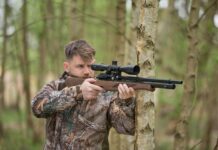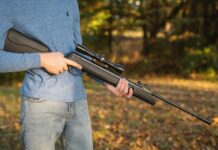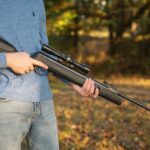A cousin of mad cow disease that eats holes in the brains of deer could be the tipping point that pushes Kansas to join other states that bar people from baiting the animals with piles of food.
Wildlife commissioners hope restricting the popular practice could slow the spread of chronic wasting disease and curb other deer-related problems, such as crop damage.
In northwest Kansas, biologists estimate at least one-third of 2.5-year-old bucks now have the fatal disease.
But opponents of a feed ban — so far, primarily people with financial interests — are raising heated complaints. That includes feed sellers, rural land brokers and hunting lodge owners.
Some Kansas lodges charge out-of-state hunters upward of $4,000 each for weeklong stays on properties where deer baiting and feeding ensures strong numbers of the country’s most popular game animal.
Lodge owners argue a ban would hurt their businesses and rural communities.
“When an outfitter or a landowner gets a thousand dollars in his pocket from outside, he don’t put it in his pocket,” Kenny Graham, who runs the 23,000-acre CK Outfitters lodge about an hour south of Topeka in Osage City, told commissioners at their June meeting. “He spends it with (a grain) elevator. He spends it to buy gas. He spends it to live on.”
Whitetail Properties Real Estate, which specializes in hunting land, is battling the potential restrictions. So is Hunter Nation, a politically conservative group that includes Kansas Attorney General Kris Kobach on the board of directors.
Whitetail Properties salesperson Todd Bigbee said rules would cause land values to drop, leading to “massive” losses.
“Especially to rural Kansas landowners who sell recreational land and lease hunting rights to others,” he said in an email to the Kansas News Service.
Biologists and veterinarians, though, have won over an increasing number of states to ban the practice of laying out corn, apples, peanuts and other food for deer.
They warn that these unnatural buffets gather deer in close proximity and spread sickness.
The National Deer Association, which promotes hunting and healthy deer populations, shares that concern. It has nothing against baiting and feeding under normal circumstances, but it supports a ban in areas with chronic wasting disease.
“There’s no doubt from the science side that baiting increases disease spread,” said wildlife biologist Kip Adams, the group’s head of conservation. “That’s very, very clear … The vast majority of wildlife professionals agree.”
Feed sellers and others who want to continue baiting in areas with disease aren’t convinced that shutting down feeding makes sense. They note that chronic wasting disease persists in states without legal baiting.
Table of Contents
Surveys of Kansas hunters and landowners
Crowding around feed undermines a key evolutionary trait — a kind of deer version of social distancing.
“Maternal family groups actually do a pretty good job of spatially segregating,” North Dakota wildlife veterinarian Charlie Bahnson told Kansas wildlife commissioners at the June meeting. “That tends to all break down when you put artificial feed on the landscape.”
A sick deer standing over a bait pile covers it in pee, poop and saliva. Other deer chowing down at the same spot pick up germs.
They could catch bovine tuberculosis, for example. Or they could swallow the prions that cause the always-fatal chronic wasting disease.
Kansas wildlife officials are revving up a public education campaign. Hunter Nation has launched a counter-campaign.
A ban would make hunting harder for many people, said Kansas lawyer Keith Mark, the group’s founder and president.
If young people can’t get close enough to animals to hit their targets, hunting won’t hold enough appeal to coax kids away from computer games and other entertainment, he said. The U.S. needs to replenish the ranks of its aging hunters.
“Being able to attract deer to a close proximity is certainly better for young hunters — really all hunters,” to kill as many deer as permitted, he said. “Isn’t that what we’re trying to do here?”
“I don’t buy that,” Adams said. “There’s a lot of places (where) kids and new hunters are shooting deer with rifles, shotguns and bows — where they cannot use bait.”
Adams wrote this month that the number of states that allow baiting has fallen from 26 to 22 in the past five years. He expects the number will keep falling as chronic wasting disease spreads.
In Kansas, wildlife biologists estimate based on carcass samples that somewhere between 33% and 48% of 2.5-year-old bucks in northwest Kansas counties now have the disease, which first cropped up in Kansas two decades ago.
They peg the rates at 10-16% in north-central Kansas, 9%-21% in southwestern Kansas, 1%-4% in south-central Kansas and about 1% for eastern Kansas.
Skeptics reject those estimates and want more testing.
Tim Neuman, a wildlife biologist employed by feed and supplement manufacturer Ani-logics Outdoors, argues that banning the use of these products would be “counterproductive” because some landowners would ignore that and carry on. Then more animals would end up congregating at those spots.
“It makes it worse because it concentrates deer even more,” he said, so “there’s only half as much (feed), but there’s still the same amount of deer.”
He urged Kansas to hold off and see if researchers can find preventive treatments.
“We are still in the infancy with the knowledge of chronic wasting disease,” he said.
Many Kansans enjoy increasing their chances of shooting a deer or watching and photographing the creatures by putting out food.
The Kansas Bowhunters Association will remain neutral on potential regulations, because its membership is torn, president Bob McCartney said. The group’s executive council has decided to support whatever decision the state wildlife agency reaches.
In 2020, the Kansas Department of Wildlife and Parks surveyed hunters and found 54% of respondents would oppose a total ban on bait and mineral supplements that attract game.
Last year, the department commissioned a survey of landowners that found 45% either feed deer on their land or allow someone else to do it.
Still, the state’s wildlife commissioners feel compelled by science to push toward regulation.
“I think the commission would all vote to ban baiting today,” commissioner Troy Sporer said in June. He asked department staff to make clear to the public that the state’s wildlife commissioners want “to ban baiting, in time.”
“They need to know (that) is our intention,” he said.
The seven-person commission guides the department’s actions. Its members are appointed to staggered four-year terms by the governor.
Staff will schedule town hall meetings in coming months. They’re also hoping to convince the public that it’s better to support deer by creating healthy habitats.
Deer benefit when landowners remove invasive trees and restore prairie, for example. The animals forage and hide in the grasses, which help fawns avoid hypothermia.
Landowners can also plant fields of buckwheat, cowpeas and other deer favorites. States consider this less hazardous than laying out food because deer keep their mouths farther away from bodily fluids on the ground and don’t crowd around a pile.
What do other states do?
It’s not clear whether Kansas wildlife commissioners will ultimately vote on a statewide, yearlong ban on baiting and feeding game or some kind of partial limitations.
A dozen Midwest states have various kinds of restrictions on the practices.
Baiting and feeding are terms used differently by various agencies and groups. Some distinguish between the two based on the goals or quality of the food. However, both words refer to setting out food in piles or with a dispenser.
Illinois opted for a statewide ban. In Nebraska, hunters can put out food but can’t shoot deer within 200 yards of it.
North Dakota bans baiting and feeding in areas with confirmed chronic wasting disease.
Bahnson, the North Dakota veterinarian, said officials take flak when they act.
“It generates a lot of pretty strong emotional responses,” he said. “Frankly, it’s not very fun to deal with from an agency standpoint.”
North Dakota lawmakers tried this year to strip the state’s wildlife officials of their ability to limit baiting, but they ultimately failed.
Bahnson said North Dakota hunters generally didn’t bait deer until a few decades ago. It became common at lodges, he said, and popular with bowhunters.
The story of chronic wasting disease
Wild elk started testing positive for chronic wasting disease in the 1980s in Colorado. Today, the disease has reached 30 more states and parts of Canada.
The prion — a kind of deformed protein — infects deer, elk and similar animals, slowly destroying their brains.
No people have gotten sick, but health authorities worry. Human exposure to mad cow disease has killed more than 200 people worldwide since its discovery in the 1990s.
The Centers for Disease Control and Prevention urges hunters to don impermeable gloves before cutting carcasses. Hunters should extract a sample for a chronic wasting disease test and shouldn’t eat the meat if it tests positive.
Kansas officials found a first case in 2001 in a captive elk southwest of Wichita. Wild animals started testing positive elsewhere in the state starting in 2005.
Since then, the Kansas State Veterinary Diagnostic Lab has confirmed cases in most counties. Western Kansas is a particular hotspot.
But hunting fuels a corner of the economy that often clashes with regulation.
In the book Deerland, writer and hunter Al Cambronne documents the political backlash in Wisconsin from feed mills in the early 2000s.
They won over state lawmakers to undo baiting restrictions that the state had imposed to slow the spread of chronic wasting disease.
One family-run feed mill said it lost more than $85,000 in a single winter during the ban.
Today, baiting is allowed in a few Wisconsin counties, but prohibited in most.
Businessowners in Kansas fear major losses, too.
In Osage County and Coffee County alone, anti-feeding rules would put three people out of business, lodge owner Graham warned Kansas wildlife commissioners.
“We contribute to the economy,” he said. “We care about the habitat.”
Hunter Nation also makes an economic case. It points to data from the Sportsmen’s Alliance, whose membership includes major hunting retailers and ammunition suppliers.
A report commissioned by the group estimates people seeking to hunt deer and other animals forked out more than $500 million on equipment, travel and related services in Kansas in 2020.
The report does not indicate how a ban on baiting and feeding would affect this spending.
Wildlife officials are considering putting a stop to baiting and feeding not just to slow the spread of disease, but also because the practices can lead to extra high deer numbers in some areas.
This can lead, for example, to localized damage to bird and pollinator habitat or complaints from farmers about crop damage.
Biologists are also concerned that corn is the most common deer feed.
If deer eat too much corn, this can give them health conditions. Yet the animals can’t turn down the starches in it, said Levi Jaster, a biologist and big game coordinator at the wildlife department. It’s the cervid version of potato chips.
“I like potato chips,” he said. “Rarely do I open a bag and eat (just) one … even though I know they’re bad for me.”
Critics of the agency shoot back that corn is so ubiquitous on Kansas farmland that the animals will eat plenty of it no matter what.
Celia Llopis-Jepsen is the environment reporter for the Kansas News Service. You can follow her on Twitter @celia_LJ or email her at celia (at) kcur (dot) org.
The Kansas News Service is a collaboration of KCUR, Kansas Public Radio, KMUW and High Plains Public Radio focused on health, the social determinants of health and their connection to public policy.
Kansas News Service stories and photos may be republished by news media at no cost with proper attribution and a link to ksnewsservice.org.











































